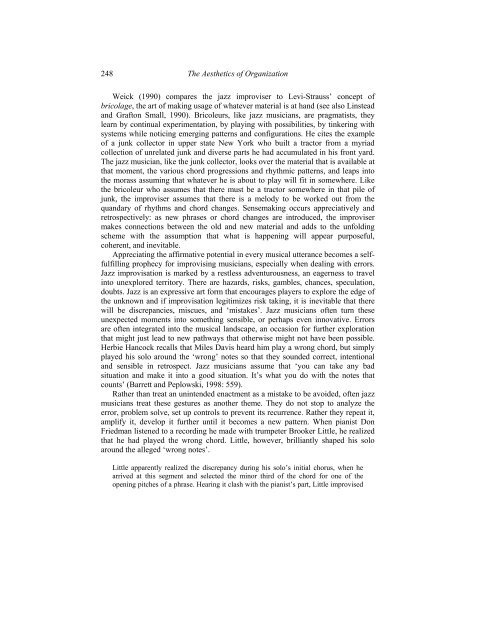Cultivating aesthetics - iSites
Cultivating aesthetics - iSites
Cultivating aesthetics - iSites
You also want an ePaper? Increase the reach of your titles
YUMPU automatically turns print PDFs into web optimized ePapers that Google loves.
248<br />
The Aesthetics of Organization<br />
Weick (1990) compares the jazz improviser to Levi-Strauss’ concept of<br />
bricolage, the art of making usage of whatever material is at hand (see also Linstead<br />
and Grafton Small, 1990). Bricoleurs, like jazz musicians, are pragmatists, they<br />
learn by continual experimentation, by playing with possibilities, by tinkering with<br />
systems while noticing emerging patterns and configurations. He cites the example<br />
of a junk collector in upper state New York who built a tractor from a myriad<br />
collection of unrelated junk and diverse parts he had accumulated in his front yard.<br />
The jazz musician, like the junk collector, looks over the material that is available at<br />
that moment, the various chord progressions and rhythmic patterns, and leaps into<br />
the morass assuming that whatever he is about to play will fit in somewhere. Like<br />
the bricoleur who assumes that there must be a tractor somewhere in that pile of<br />
junk, the improviser assumes that there is a melody to be worked out from the<br />
quandary of rhythms and chord changes. Sensemaking occurs appreciatively and<br />
retrospectively: as new phrases or chord changes are introduced, the improviser<br />
makes connections between the old and new material and adds to the unfolding<br />
scheme with the assumption that what is happening will appear purposeful,<br />
coherent, and inevitable.<br />
Appreciating the affirmative potential in every musical utterance becomes a selffulfilling<br />
prophecy for improvising musicians, especially when dealing with errors.<br />
Jazz improvisation is marked by a restless adventurousness, an eagerness to travel<br />
into unexplored territory. There are hazards, risks, gambles, chances, speculation,<br />
doubts. Jazz is an expressive art form that encourages players to explore the edge of<br />
the unknown and if improvisation legitimizes risk taking, it is inevitable that there<br />
will be discrepancies, miscues, and ‘mistakes’. Jazz musicians often turn these<br />
unexpected moments into something sensible, or perhaps even innovative. Errors<br />
are often integrated into the musical landscape, an occasion for further exploration<br />
that might just lead to new pathways that otherwise might not have been possible.<br />
Herbie Hancock recalls that Miles Davis heard him play a wrong chord, but simply<br />
played his solo around the ‘wrong’ notes so that they sounded correct, intentional<br />
and sensible in retrospect. Jazz musicians assume that ‘you can take any bad<br />
situation and make it into a good situation. It’s what you do with the notes that<br />
counts’ (Barrett and Peplowski, 1998: 559).<br />
Rather than treat an unintended enactment as a mistake to be avoided, often jazz<br />
musicians treat these gestures as another theme. They do not stop to analyze the<br />
error, problem solve, set up controls to prevent its recurrence. Rather they repeat it,<br />
amplify it, develop it further until it becomes a new pattern. When pianist Don<br />
Friedman listened to a recording he made with trumpeter Brooker Little, he realized<br />
that he had played the wrong chord. Little, however, brilliantly shaped his solo<br />
around the alleged ‘wrong notes’.<br />
Little apparently realized the discrepancy during his solo’s initial chorus, when he<br />
arrived at this segment and selected the minor third of the chord for one of the<br />
opening pitches of a phrase. Hearing it clash with the pianist’s part, Little improvised
















